In a Recession, Another Small Step for Man

The Lunar Reconnaissance Orbiter is on its way. After a flawless launch at about 5:30 Eastern Time yesterday, NASA’s nearly $600 million satellite is en route to the moon. The question now is, what’s going to follow it?
Unlike most of NASA’s recent unmanned craft, and Japan’s Kayuga satellite that traveled to the moon in 2007, the LRO is not meant to do “pure” science. It’s a craft on a mission, and that mission is to take the next step toward returning American astronauts to the moon.
The LRO will enter lunar orbit at an altitude of 30 miles, half that of the Apollo orbiter back in the 1960s. That’s close enough to give us our first good look in decades at the old Apollo landing sites, but the LRO’s main focus is the future. Besides the camera, the craft will also carry a laser altimeter, which measures the time it takes a laser to bounce back from the ground and uses that data to map the surface for landing and living sites. And the LRO’s partner satellite, the Lunar Crater Observation and Sensing Satellite, will separate into two pieces to search for water; one piece will crash into the moon to create a plume, and the other half will fly through the plume and measure its composition.
Besides searching for water and good landing spots, the LRO will also look out for potential energy sources on the lunar surface and measure the harmful cosmic rays that astronauts have to avoid. It’s all leading up to finding the best place for a potential lunar base, but the plan for that base might be in jeopardy.
In April, acting NASA chief Chris Scolese raised a ruckus by telling Congress that the agency probably wouldn’t follow through on its plan to create a permanent moon base. And the agency slogged through much of 2009 in a state of limbo. President Obama waited months to decide how closely to stick to his predecessor’s vision of sending men back to the moon.
It might seem silly to send a half-billion-dollar scout to the moon in the middle of the recession. But NASA missions require many years of planning, design and building to prepare, so there was no point in leaving the LRO on the launch pad. And last month Obama selected former astronaut Charles Bolden as NASA’s new head, a signal to some that the commander-in-chief is committed to manned exploration.
In any case, if we do make it back to the moon, we’ll be glad the LRO went ahead of us.





